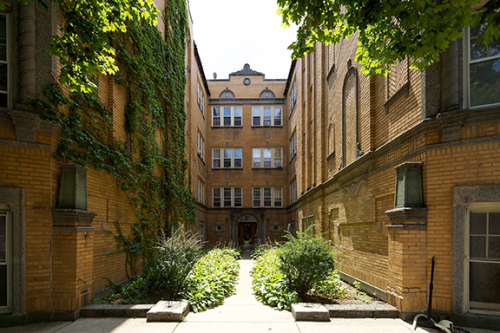Nov 10, 2014
Data reveals more evidence of uneven recovery for Cook County’s housing markets
Data reveals more evidence of uneven recovery for Cook County’s housing markets
CHICAGO — Since 2009, lending to multifamily rental buildings in Cook County’s low- and moderate-income neighborhoods has significantly lagged behind lending to the county’s middle- and upper-income areas, which have seen dramatic increases in multifamily lending during the same period, according to a report released Nov. 10 by the Institute for Housing Studies at DePaul University.
The most recent data show that multifamily lending, which is used to acquire, rehab or refinance rental buildings, is roughly 54 percent below lending levels seen in 2005 in Cook County’s low-income neighborhoods. This is compared to multifamily lending in the county’s upper-income areas, which is 79 percent above levels seen in 2005.
The report, based on Home Mortgage Disclosure Act (HMDA) data released in October, adds to evidence that Cook County’s low- and moderate-income neighborhoods, which saw the greatest impact from the foreclosure and economic crisis, are still struggling in its aftermath.
“For some time, data has shown that certain neighborhoods have essentially recovered from the housing crisis while others have struggled,” said Geoff Smith, co-author of the study and executive director of the institute. “This report adds more information about how the county’s rental housing markets are experiencing very different levels of investment, which can directly affect the quality and availability of rental housing.”
In order to determine what is driving the decline in multifamily lending in low- and moderate-income neighborhoods, the report examined the types of active multifamily lenders and the size of loans originated by those lenders by neighborhood-income level from 2005 to 2013, both before and after the economic crisis.
The institute’s analysis showed that both the number of active lenders and the number of smaller multifamily loans of less than $1 million declined dramatically since 2005. In Cook County’s low- and moderate-income neighborhoods, small loans of less than $1 million decreased nearly 62 percent since 2005, and the volume of these loans originated by small community banks declined nearly 72 percent during the same time period.
According to the report, small loans of less than $1 million are particularly important to smaller rental buildings in low-and moderate-income neighborhoods which typically have lower values and charge lower rents. The institute’s analysis shows that small multifamily rental buildings with between five and 49 units are among the key components of Cook County’s rental housing landscape, accounting for 76 percent of the county’s multifamily rental units. These buildings make up an even larger share of multifamily rental units in the county’s low- and moderate-income areas.
“Historically, small community lenders have played a key role in providing smaller loans to small-building owners in lower-income neighborhoods,” said Sarah Duda, the report’s other co-author and the institute’s associate director. “The decline of these types of loans raises concerns about where these buildings, critical to the county’s affordable rental housing stock, will find credit.”
National data shows that only one in four low-income renter households that apply for federal housing assistance receives it, with the vast majority of low-income renter households competing for private, market-rate housing that they can afford.
According to the report, the gap between the demand for and supply of affordable rental housing in Cook County declined slightly between 2011 and 2012 but still remains. The most recent data show that 176,213 additional affordable units would be needed to meet the current demand for affordable housing countywide.
The shortage of affordable units has led to an increase in the number of Cook County renter households that are rent-burdened, or pay more than 30 percent of their income toward rent. In 2012, roughly 51 percent of all Cook County renter households were rent burdened according to 2012 American Community Survey census data also analyzed in the report.
“Building new rental housing is expensive and it is impossible to build new affordable rental units without substantial subsidy,” Smith said. “Closing the county’s affordability gap requires preserving existing privately owned market-rate affordable units and bringing market-rate affordable units online through the acquisition and rehab of smaller and older rental buildings.”
“We are releasing this analysis simultaneously with a report from the Preservation Compact that outlines seven strategies for preserving affordable housing in Cook County,” Smith said. “Together, these reports make clear the challenges facing the affordable rental housing stock in the county and strategies to preserve it.”
For more information about the Preservation Compact, a policy collaborative focused on the preservation of affordable rental housing in Cook County, or to read their full report, go to http://www.preservationcompact.org/2014report/.
The Institute for Housing Studies is a research center based at DePaul University that provides analysis and data to inform affordable housing policy and practice. The institute’s latest report “The State of Rental Housing in Cook County: Understanding Neighborhood Multifamily Lending Trends in the Wake of the Housing Crisis” used 2013 Home Mortgage Disclosure Act data to analyze the flow of credit to multifamily buildings in Chicago between 2005 and 2013. The report is at http://bit.ly/multifamilylendingreport.
###
Source:
Geoff Smith
gsmith33@depaul.edu
312-362-5962
Media Contact:
Tina Fassett Smith
kfassett@depaul.edu
312-362-5974

Since 2009, lending to multifamily rental buildings in Cook County’s low- and moderate-income neighborhoods has significantly lagged behind lending to the county’s middle- and upper-income areas, which have seen dramatic increases in multifamily lending during the same period, according to a report released Nov. 10 by the Institute for Housing Studies at DePaul University. (Photo by Jeff Carrion)
